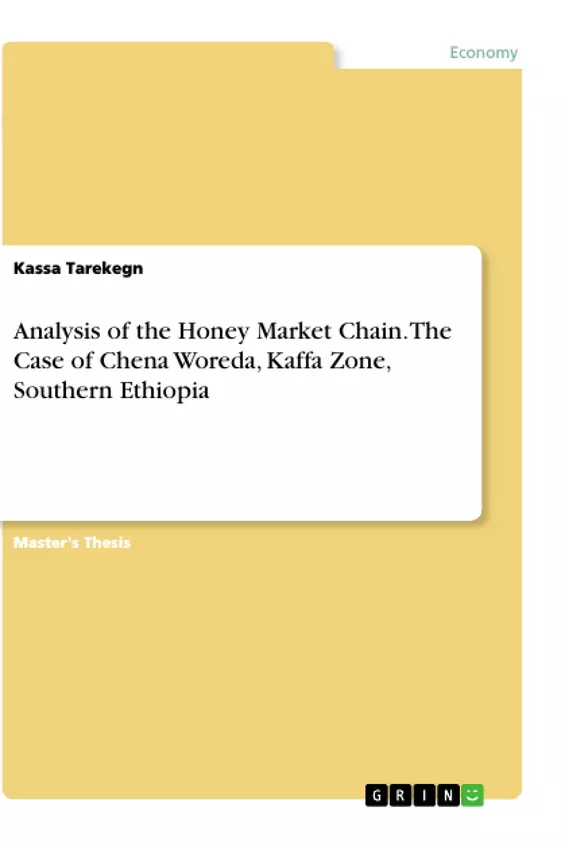The study attempted to answer the following research questions: What are the major honey marketing channels and who are the honey market chain actors and their roles in Chena woreda? How is the structure-conduct-performance of honey market in the study area? What factors influence the volume of market supply of honey in the study area? What factors influence honey producers’ market outlets choice in Chena woreda?
The thesis has been organized under five chapters. Chapter one pinpoints background, statement of the problem, research questions, objectives, significance of the study, scope and limitations of the study and organization of the thesis. Chapter two presents review of theoretical and empirical evidences related to the study. Chapter three discusses research methodology (description of the study area, data types and sources, methods of data collection, sampling techniques and methods of data analysis) of the study. Chapter four presents’ descriptive and econometric results and discussed in detail. Chapter five summarizes the main findings of the study and draws conclusion and recommendations.
Inhaltsverzeichnis (Table of Contents)
- 1. INTRODUCTION
- 1.1. Background of the Study
- 1.2. Statement of the Problem
- 1.3. Research Questions
- 1.4. Objective of the Study
- 1.5. Significance of the Study
- 1.6. Scope and Limitations of the Study
- 1.7. Organization of the Thesis
- 2. LITRATURE REVIEW
- 2.1. Definition of Terms and Basic Concepts of Market Chain Analysis
- 2.2. Honey Production and Marketing in Ethiopia
- 2.3. Approaches to the Study of Agricultural Marketing
- 2.4. Analytical Framework for the Study
- 2.4.1. Structure, conduct and performance (SCP) of market
- 2.4.1.1. Structure of the market
- 2.4.1.2. Conduct of the market
- 2.4.1.3. Performance of the market
- 2.4.2. Factors affecting volume of market supply
- 2.4.3. Determinants of market outlet choices
Zielsetzung und Themenschwerpunkte (Objectives and Key Themes)
This thesis aims to analyze the honey market chain in Chena Woreda, Kaffa Zone, Southern Ethiopia. The research seeks to understand the structure, conduct, and performance of the honey market, identifying key factors affecting market supply and outlet choices.
- Structure, conduct, and performance (SCP) of the honey market chain
- Factors influencing the volume of honey supply in the market
- Determinants of honey market outlet choices
- Challenges and opportunities for honey producers and traders
- Policy recommendations for improving the honey market chain
Zusammenfassung der Kapitel (Chapter Summaries)
- Chapter 1: Introduction - This chapter provides background information on the study, outlines the research problem, research questions, objectives, significance, scope, and limitations, and explains the thesis's organization.
- Chapter 2: Literature Review - This chapter reviews relevant literature on market chain analysis, honey production and marketing in Ethiopia, approaches to studying agricultural marketing, and analytical frameworks used in the study.
Schlüsselwörter (Keywords)
The primary keywords and focus topics of this thesis include honey market chain, market structure, market conduct, market performance, honey production, marketing channels, supply chain analysis, agricultural economics, Ethiopia.
- Arbeit zitieren
- Kassa Tarekegn (Autor:in), 2017, Analysis of the Honey Market Chain. The Case of Chena Woreda, Kaffa Zone, Southern Ethiopia, München, GRIN Verlag, https://www.grin.com/document/989338



